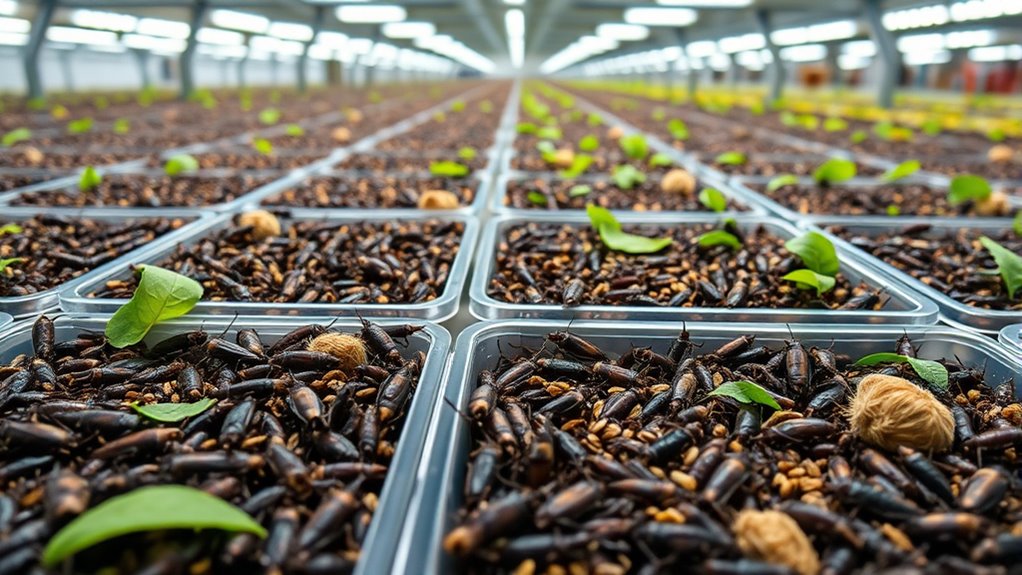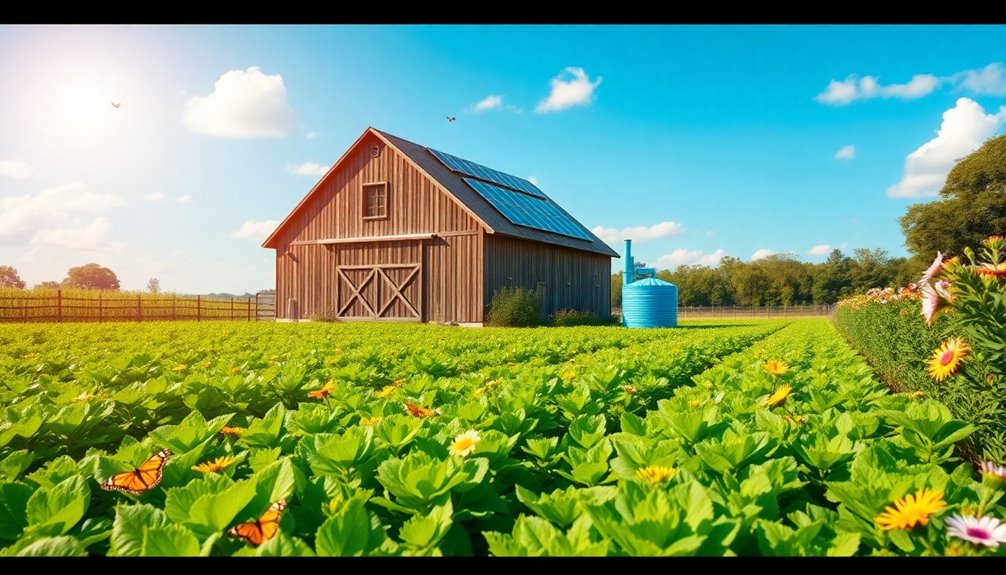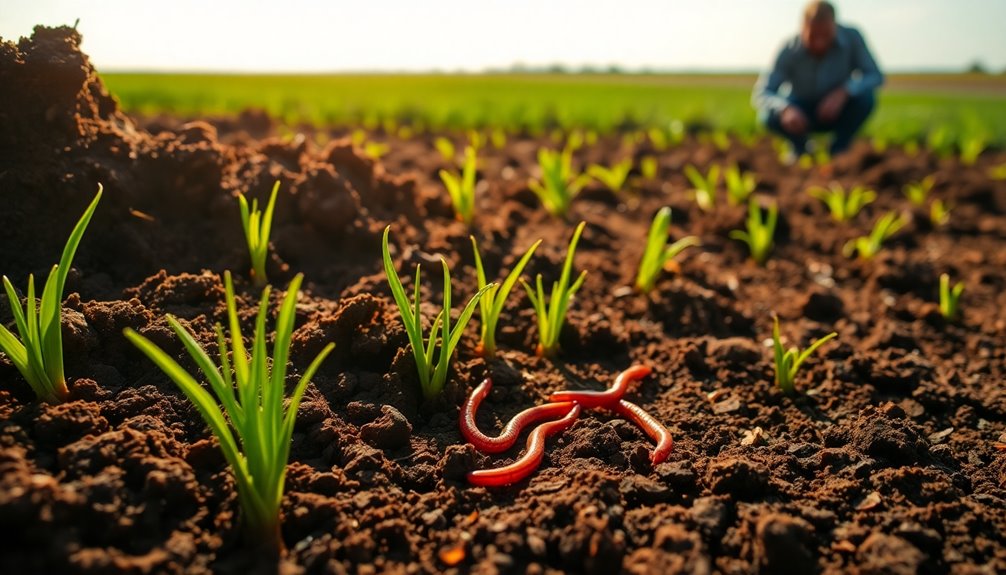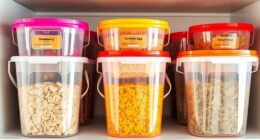Exploring small-scale insect farming is a sustainable way to boost your protein intake while reducing environmental impacts. Insects like crickets and mealworms require less land, water, and feed compared to traditional livestock, and they produce minimal greenhouse gases. Setting up a simple, well-ventilated space with the right equipment allows you to efficiently farm and process insects into snacks or ingredients. Keep exploring to discover how you can start your own insect farm and enjoy its benefits.
Key Takeaways
- Small-scale insect farming offers sustainable, resource-efficient protein sources suitable for local food systems.
- Proper site selection and environmental control are essential for healthy insect growth and production.
- Essential equipment includes ventilated containers, heating, lighting, and monitoring tools to maintain optimal conditions.
- Cultivating insects like crickets and mealworms can diversify diets and reduce reliance on traditional livestock.
- Challenges such as consumer acceptance and supply chain scalability can be addressed through education and innovative practices.
The Environmental Advantages of Insect Farming
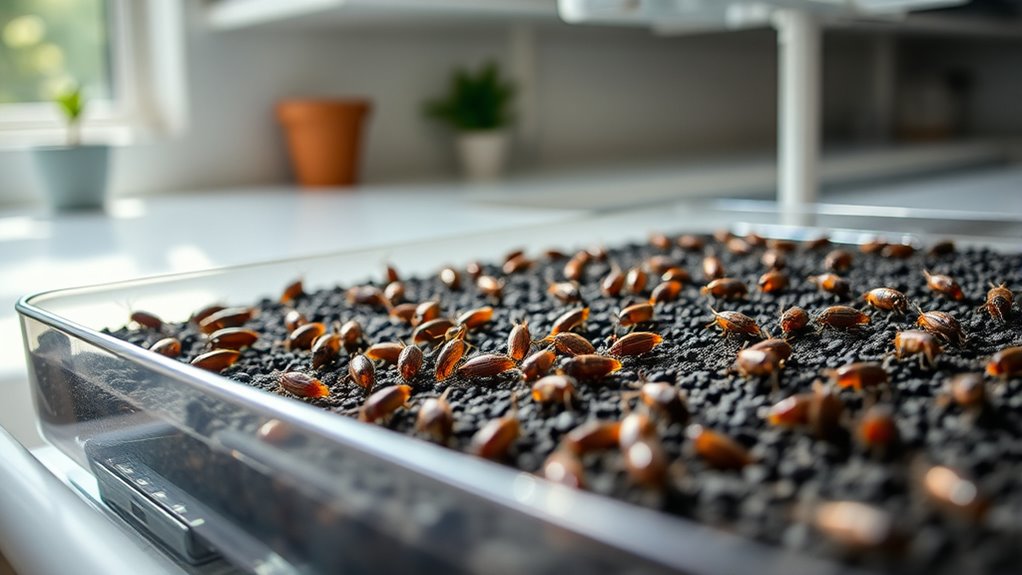
Insect farming offers significant environmental benefits compared to traditional livestock. You’ll notice that insects require far less land, water, and feed to produce the same amount of protein. Unlike cattle, which emit large quantities of methane, insects produce minimal greenhouse gases, helping reduce your carbon footprint. They grow quickly, often reaching harvest size in a few weeks, so you can produce more with less resource investment. Additionally, insects can be fed organic waste or by-products, turning waste into valuable protein without competing with human food crops. This efficient conversion process means you’re not only conserving natural resources but also reducing waste and pollution. Engaging in insect farming supports sustainable practices, which are crucial for mitigating environmental impacts and promoting long-term food security.
Popular Insects for Small-Scale Cultivation
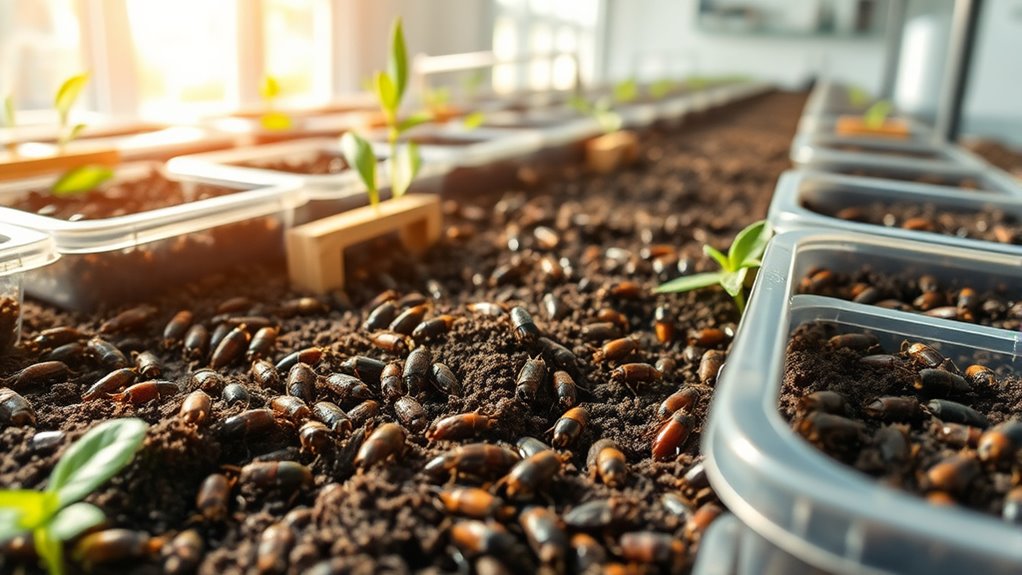
If you’re interested in starting small-scale insect cultivation, several species stand out as popular choices due to their ease of farming and high nutritional value. Crickets are a top option because they grow quickly, require minimal space, and are rich in protein, vitamins, and minerals. Mealworms are also popular; they’re hardy and thrive on simple feed, making them ideal for beginners. Black soldier fly larvae are valued for their ability to convert organic waste into valuable biomass, reducing waste and providing nutritious feed. Locusts, though less common, are efficient and have a well-established culinary history in some cultures. These insects are adaptable, low-maintenance, and provide a sustainable alternative protein source suitable for small-scale setups. Sustainable farming practices can further enhance the environmental benefits of small-scale insect cultivation.
Setting Up Your Insect Farming Space
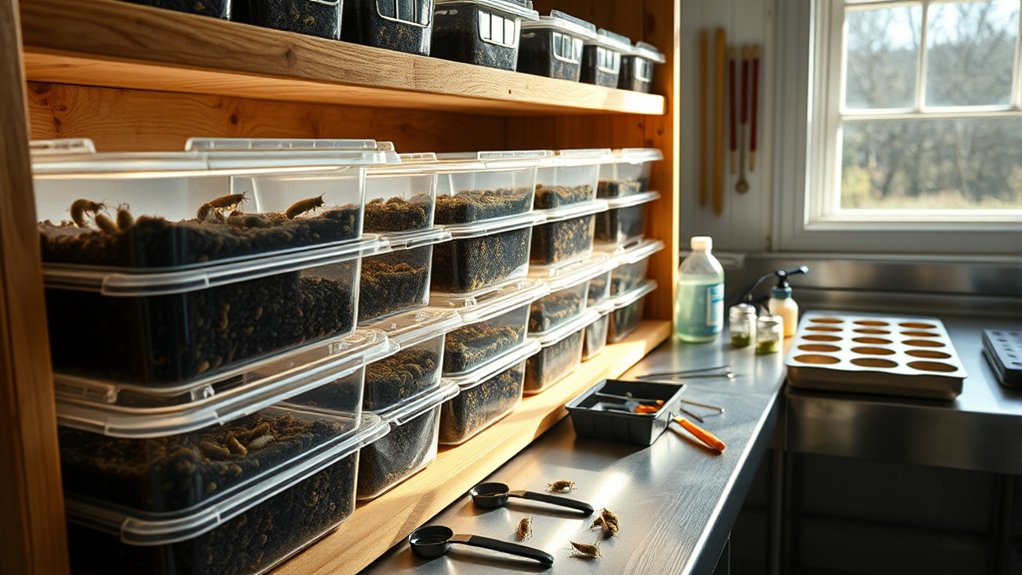
Choosing the right location is key to successful insect farming, so look for a space that’s easy to control and access. You’ll need essential equipment like climate controls, containers, and lighting to keep your insects healthy. Maintaining ideal conditions ensures your farm runs smoothly and produces quality protein. Additionally, understanding local zoning laws can help you select an appropriate site that complies with regulations.
Choosing the Right Location
Selecting the right location is crucial to guarantee your insect farming operation runs smoothly and efficiently. You want a space that’s easy to access, clean, and well-ventilated. Choose a spot away from direct sunlight, which can cause temperature fluctuations, and avoid areas prone to drafts or extreme humidity. Ensure the space has a reliable power source for lighting and temperature control. It should also be close to waste disposal and supply areas to streamline your workflow. Consider the size of your operation—leave enough room for future growth and equipment setup. Keep in mind local regulations and zoning laws that might restrict or guide your choice. A well-chosen location helps you maintain ideal conditions, minimizes risks, and keeps your operation productive. Additionally, celebrity lifestyle insights can inspire innovative design ideas for creating an optimal farming environment.
Essential Equipment Needed
Setting up your insect farming space requires assembling the right equipment to maintain ideal conditions and streamline operations. You’ll need sturdy, ventilated containers or bins with proper lids to prevent escapes and allow airflow. A reliable heating source, like heat mats or lamps, helps maintain temperature, especially in cooler environments. Humidity control is essential, so include a spray bottle or humidifier to keep moisture levels steady. Lighting, such as LED grow lights, can support insect activity and growth. A digital thermometer and hygrometer will help you monitor temperature and humidity accurately. Additionally, you’ll need a workspace with easy access to cleaning tools, like brushes and disinfectants, to keep the environment hygienic. Investing in quality equipment ensures your insect farm runs smoothly and efficiently. Proper environmental monitoring is crucial for optimizing insect health and productivity.
Maintaining Optimal Conditions
Have you considered how crucial it is to keep your insect farming environment stable? Maintaining the right temperature, humidity, and ventilation is essential for healthy insect growth. Keep the space between 75-85°F (24-29°C) and humidity around 60-70%. Use a thermometer and hygrometer to monitor conditions regularly. Ensure proper airflow by avoiding stagnant air, which can promote mold or pests. Cover containers loosely to allow ventilation while preventing escapes. Avoid direct sunlight, which can cause temperature spikes, and place your setup in a stable environment away from drafts or temperature fluctuations. Consistent conditions help insects thrive, grow faster, and produce quality protein. Regularly check and adjust your environment to keep conditions ideal, ensuring a successful and sustainable insect farm. Additionally, understanding air purifier technologies can help you improve ventilation and air quality in your farming space.
Essential Equipment and Supplies
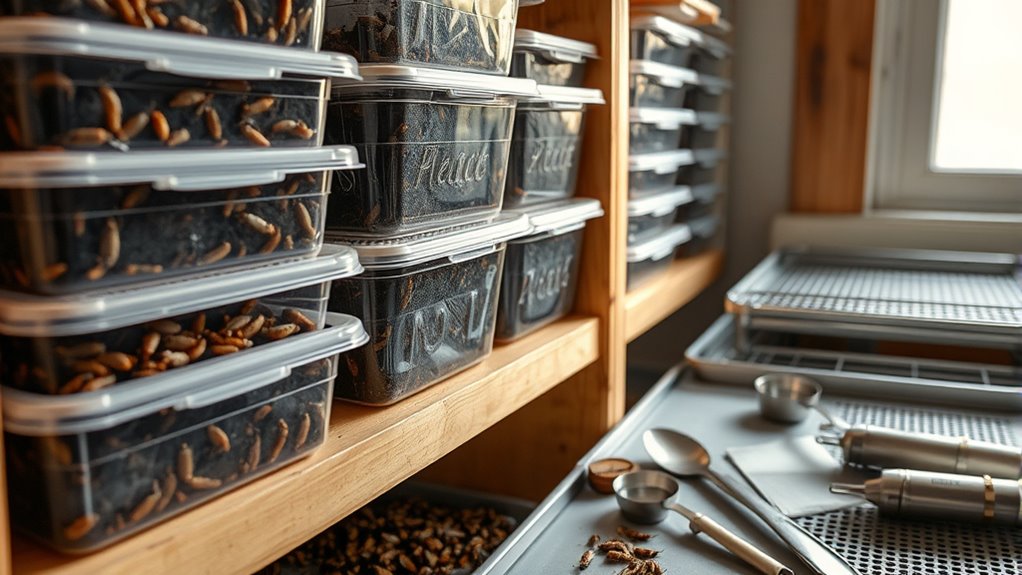
To successfully venture into alternative protein cooking, you’ll need the right equipment and supplies. Start with sturdy containers or bins for housing your insects, ensuring they have proper ventilation. You’ll also want a reliable heat source, like a heat mat or lamp, to maintain consistent temperatures. A digital thermometer helps monitor conditions, preventing stress or death. Fine mesh screens or filters are essential for separating insects from waste or harvesting. Keep a supply of organic substrate, such as grains or vegetable scraps, to feed your insects. Additionally, have moisture sources like water dishes or spray bottles to keep humidity levels stable. Proper pinball machine weight awareness is crucial for home installation and safety. Finally, clean tools and gloves help maintain hygiene and prevent contamination. With these essentials, you’re set to start your insect farming journey effectively.
Best Practices for Breeding and Care
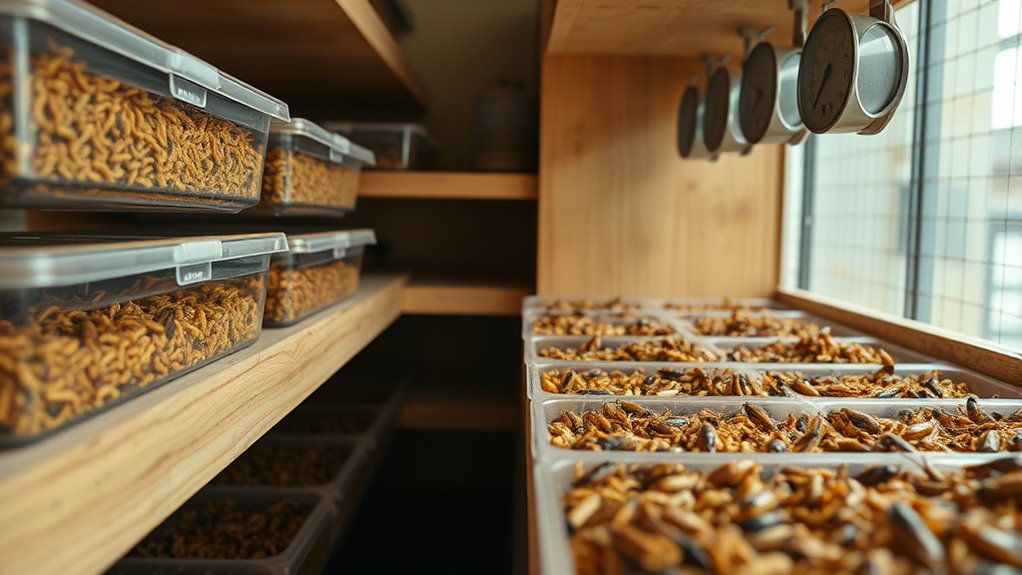
Setting up an ideal habitat is essential for healthy breeding and growth, so make sure your environment is clean, spacious, and well-ventilated. Providing proper nutrition and monitoring health regularly helps prevent issues and keeps your creatures thriving. When you pay close attention to these basics, you’ll set a strong foundation for successful breeding and care.
Optimal Habitat Setup
Creating an ideal habitat is essential for successful breeding and care of alternative proteins. You want to guarantee the environment is clean, well-ventilated, and maintains consistent temperature and humidity levels. Use containers that are easy to clean and provide ample space for movement. Incorporate bedding materials like coconut coir or vermiculite to help maintain moisture and support burrowing behaviors. Avoid overcrowding, which can lead to stress and disease. Keep the habitat free of mold and pests by regularly inspecting and cleaning. Proper lighting, such as natural or low-intensity artificial light, supports activity cycles without causing stress. Ensuring proper ventilation helps prevent the buildup of harmful gases and maintains good air quality. By setting up a clean, stable, and spacious environment, you give your insects the best chance to thrive and reproduce efficiently.
Nutrition and Health
Maintaining proper nutrition and health is essential for the success of your alternative protein cultivation. You need to provide a balanced diet, monitor for signs of illness, and guarantee ideal living conditions. Proper nutrition boosts growth rates and reproductive success, while good health minimizes disease risks. Regularly check your insects for abnormalities and keep their environment clean. To enhance their well-being, consider these best practices:
- Provide nutrient-rich feed tailored to species needs
- Maintain ideal temperature and humidity levels
- Implement regular cleaning and sanitation routines
- Monitor for pests and parasites
- Quarantine new or sick insects promptly
- Understanding nutritional requirements is vital for optimizing growth and health.
Following these practices helps ensure a healthy, productive insect farm, ultimately improving your protein yield and sustainability efforts.
Processing and Using Insects in Your Diet

Although it might seem unconventional, incorporating insects into your diet is simpler than you think. You can easily process insects into familiar forms like powders or protein bars, making them accessible and appealing. Start by drying and grinding insects into a fine flour, which can be added to smoothies, baking, or pasta dough. Using insects in recipes not only boosts nutrition but also reduces waste and environmental impact. To help visualize this, consider the following:
| Insect-Based Product | Usage Example |
|---|---|
| Insect Flour | Pancakes, muffins, smoothies |
| Protein Bars | On-the-go snacks |
| Crispy Snacks | Salty, crunchy treats |
| Powders | Smoothies, cereals |
| Cooked Whole | Tacos, salads |
Embrace the versatility—your meals will be both nutritious and sustainable. Processing methods can further enhance the appeal and ease of use for insect-derived ingredients.
Overcoming Challenges and Ensuring Sustainability
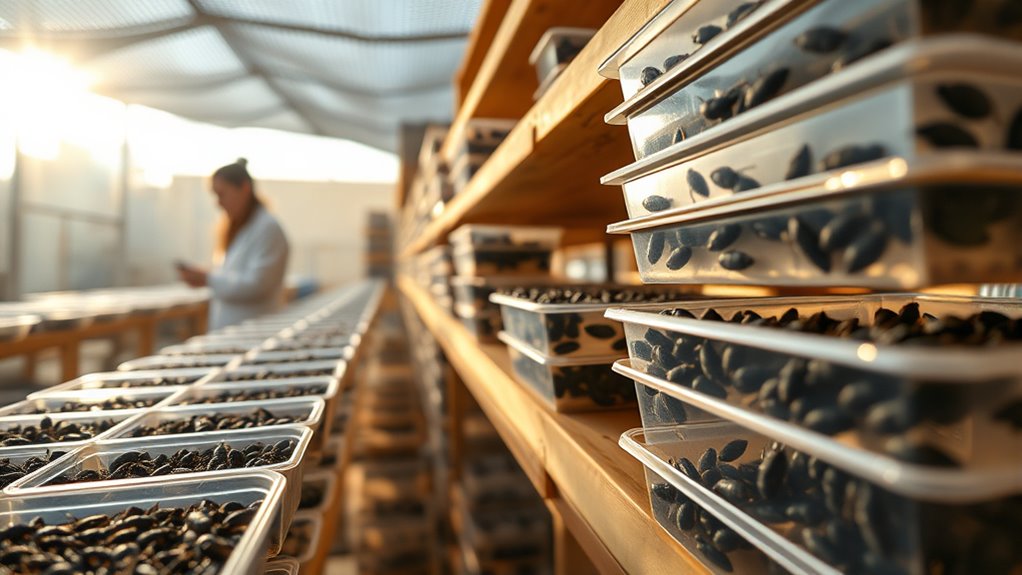
Despite the promising potential of alternative proteins, overcoming challenges like consumer acceptance, supply chain issues, and environmental impacts requires proactive strategies. You need to educate consumers on the benefits, address cultural biases, and promote transparency to boost acceptance. Improving supply chain logistics ensures consistent, scalable production. You should also invest in sustainable farming practices that minimize environmental footprints, such as efficient feed use and waste management. Additionally, collaborate with policymakers to develop supportive regulations. To ensure long-term sustainability, consider diversifying insect species, optimizing farming techniques, and monitoring ecological impacts.
- Conduct consumer awareness campaigns
- Develop scalable, efficient farming methods
- Implement eco-friendly waste management systems
- Foster industry regulations and standards
- Promote research on environmental impacts
Frequently Asked Questions
What Are the Legal Regulations Surrounding Small-Scale Insect Farming?
You need to check local regulations, as rules vary by region. Many countries require insect farmers to register their operations, follow hygiene standards, and guarantee proper waste disposal. Some places restrict certain insect species or limit farm sizes. You should also obtain necessary permits before starting. Staying informed about legal requirements helps you avoid fines and ensures your farming practices are compliant and safe.
How Much Does Initial Startup Cost Typically Range for Beginners?
You can expect initial startup costs to range from $200 to $1,000, depending on your scale and setup. Imagine a modest garage transformed into an insect farm—a stark contrast between the humble investment and the potential for sustainable protein. You’ll need basic equipment like containers, a heating source, and feed. While costs vary, starting small keeps expenses manageable, allowing you to test the waters without a hefty financial leap.
Are There Specific Insects Suitable for Urban Farming Environments?
Yes, you can farm crickets, mealworms, and black soldier fly larvae in urban settings. These insects thrive in small, controlled environments and don’t require much space. They adapt well to indoor containers or small outdoor setups, making them ideal for city dwellers. Just guarantee proper ventilation, temperature control, and hygiene. With the right setup, you can efficiently produce protein while keeping everything contained within your urban space.
How Do I Market and Sell Edible Insects Locally?
You can market and sell edible insects locally by creating vibrant farmer’s markets booths with colorful displays of crispy roasted crickets and chirping snack packs. Share the story behind sustainable protein on social media, offering tasting samples to entice curious customers. Partner with local restaurants, cafes, and health food stores to feature your insects as a nutritious, eco-friendly option. Building community connections and emphasizing your product’s freshness will turn passersby into loyal buyers.
What Are the Potential Health Risks and Safety Considerations?
You should be aware that consuming insects can carry health risks like allergic reactions, especially if you’re allergic to shellfish or dust mites. Make certain proper hygiene, source insects from reputable suppliers, and cook them thoroughly to eliminate pathogens. It’s also essential to adhere to local food safety regulations, keep detailed records, and monitor for any adverse reactions. Regular testing and sanitation help minimize risks and make sure safe, healthy insect products for your customers.
Conclusion
So, as you plunge into small-scale insect farming, remember, you’re helping the planet—by farming tiny creatures that thrive on waste. Ironically, it’s often easier to care for your insects than to change your own eating habits. But hey, if insects can help save the environment, maybe it’s time we all swallow a little bit of irony and get used to the idea. Who knew the future of food could be so small and sustainable?

